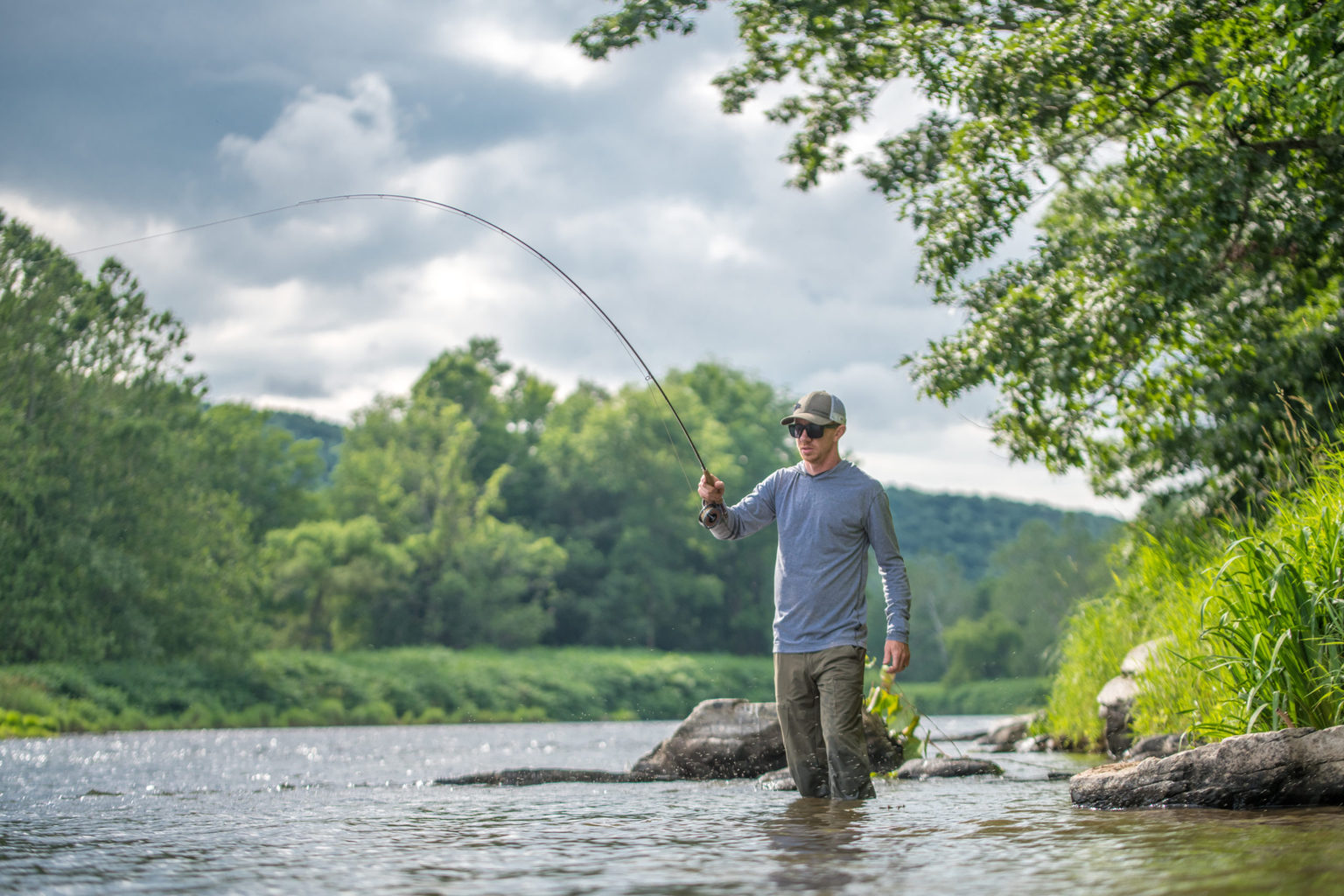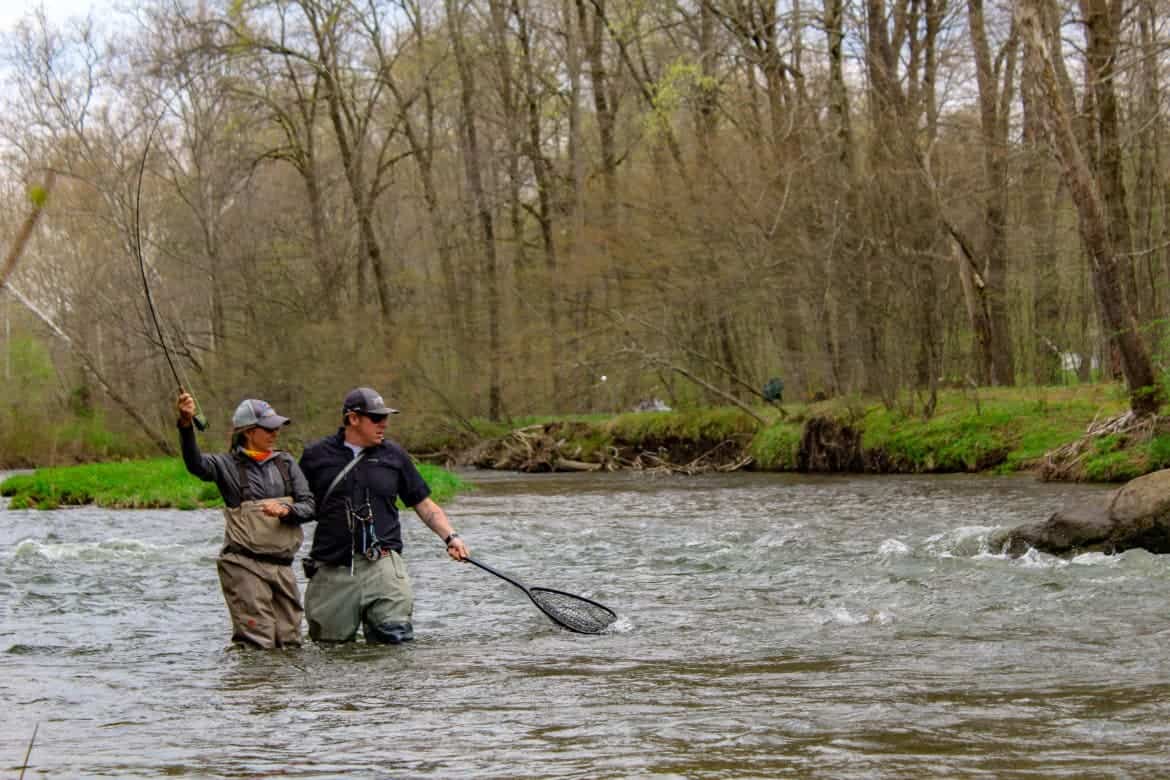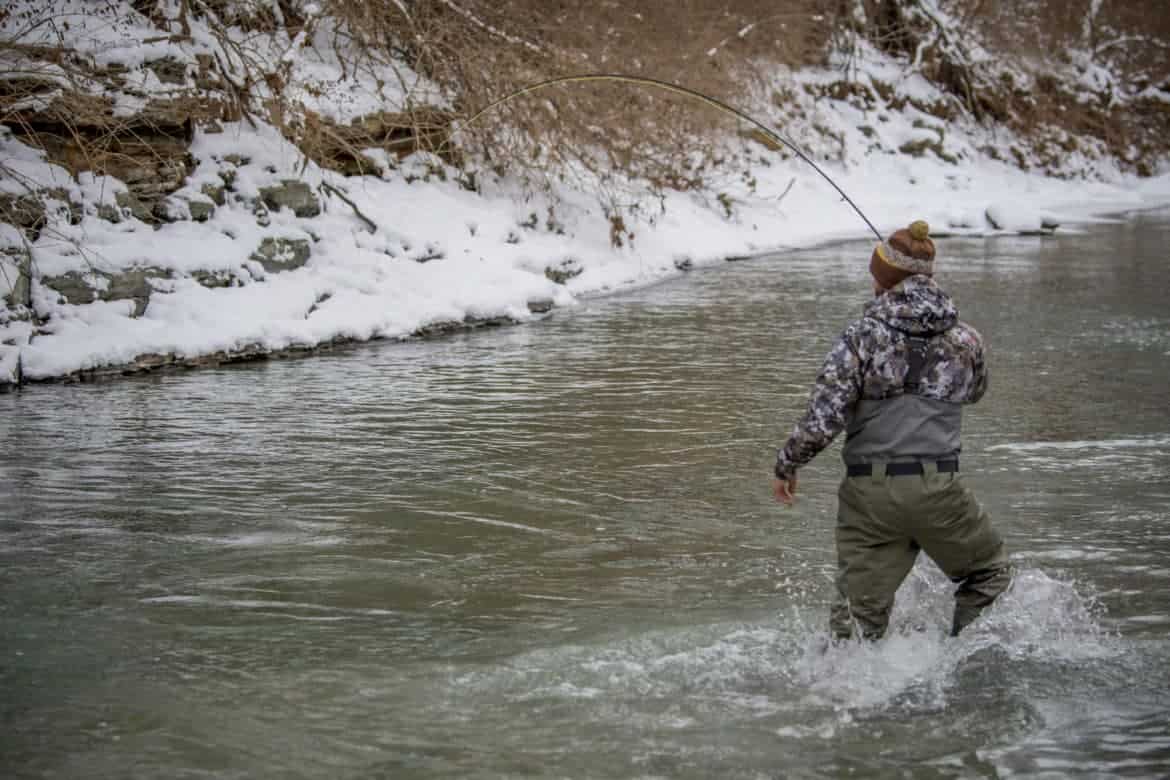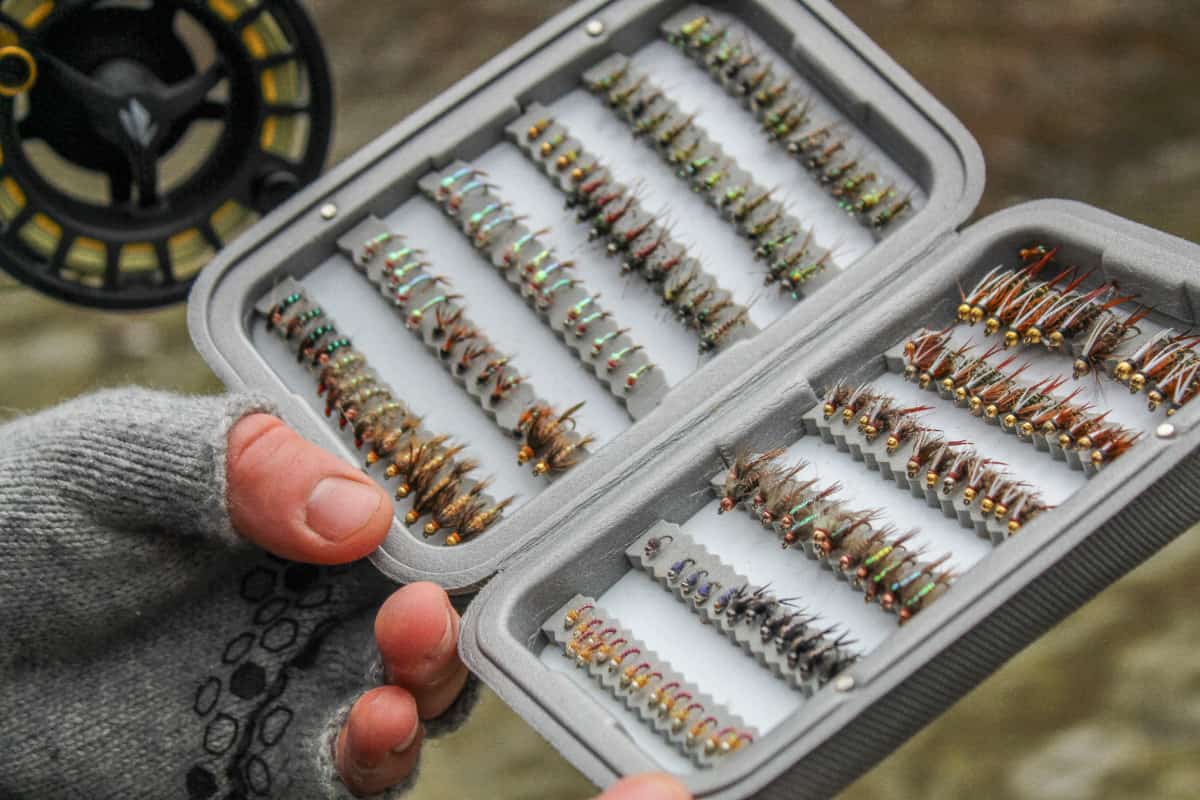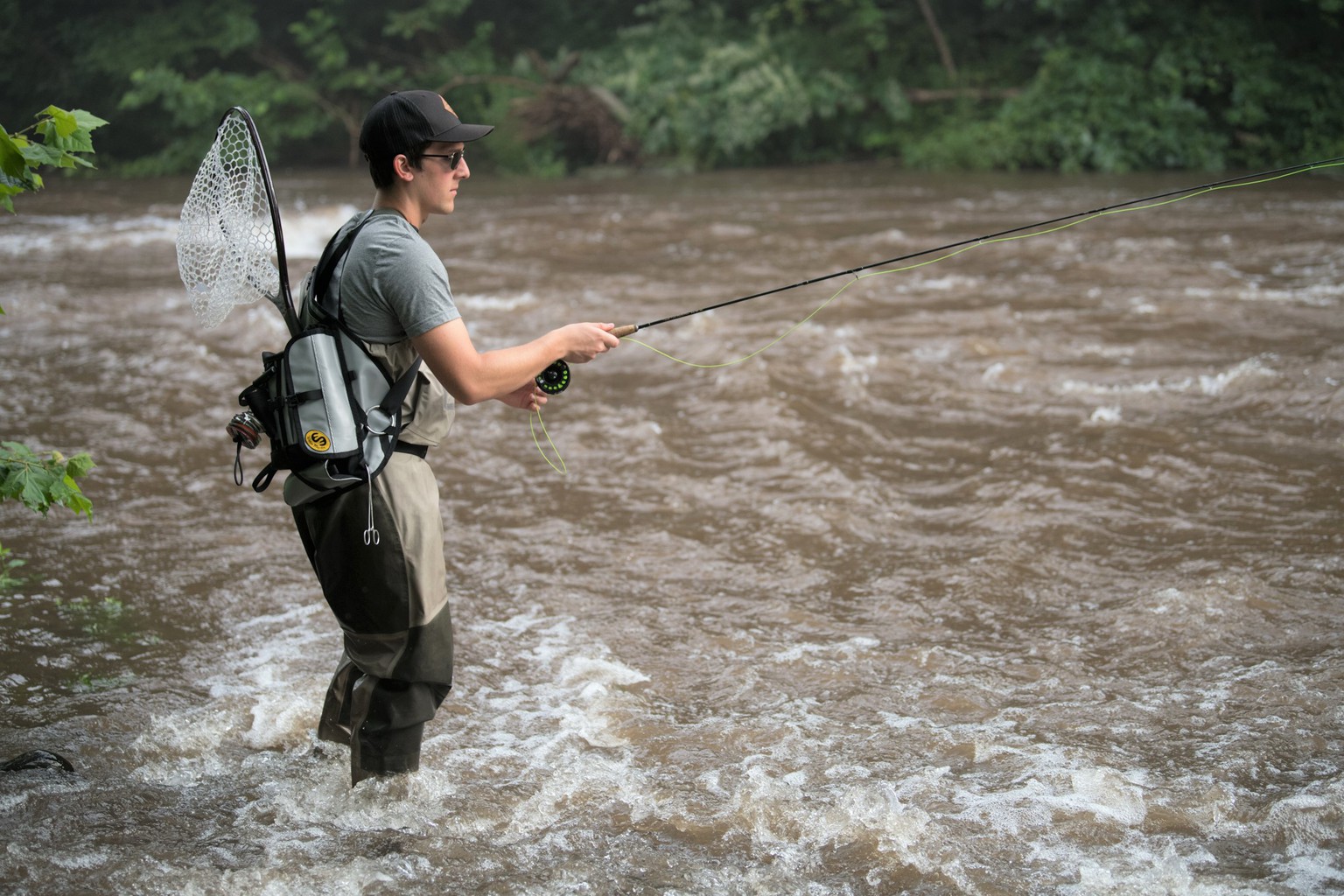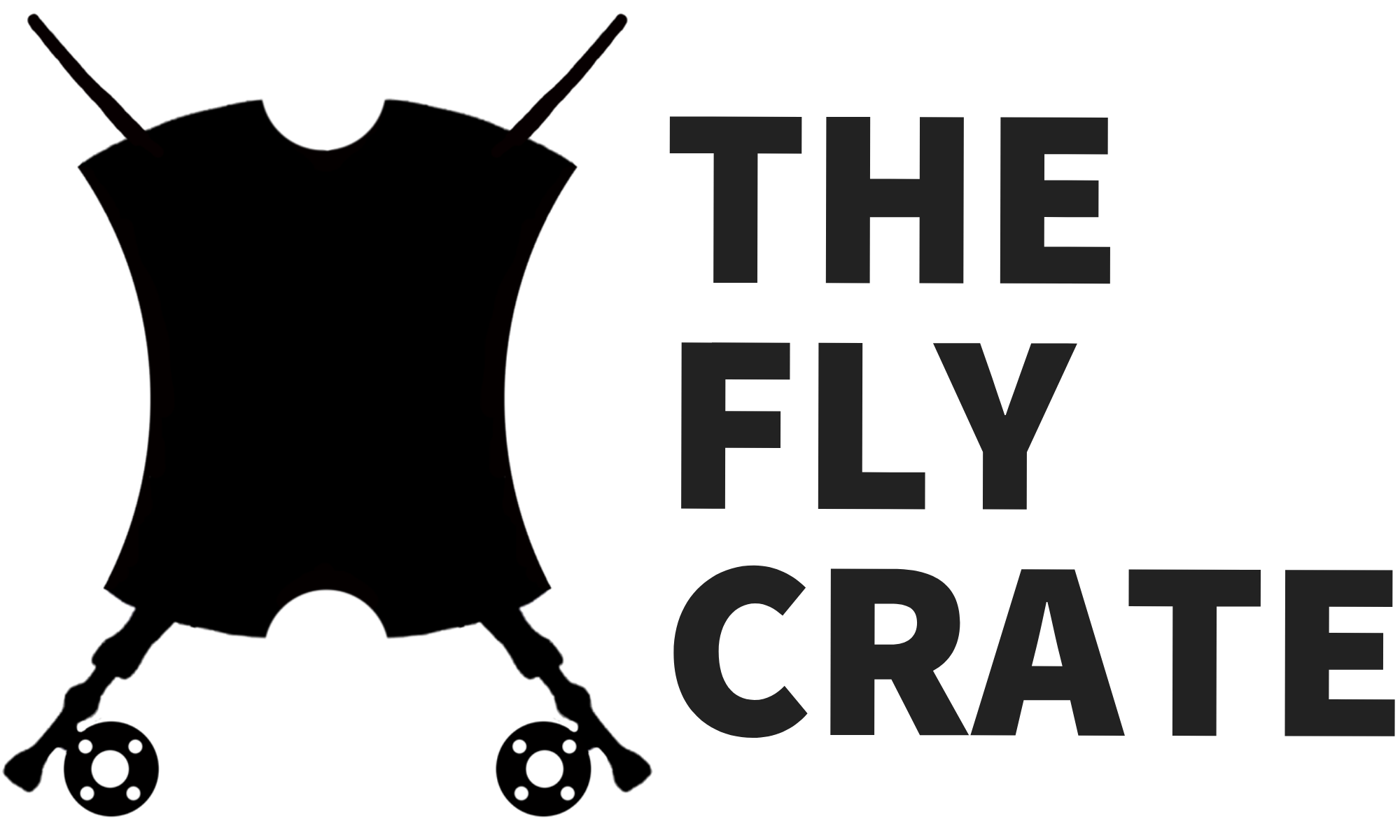How to Fly Fish Grasshopper Flies and Terrestrials
The intense buzzing can be heard from the truck as rods are hastily rigged with giant globs of foam with spider-looking legs dangling from all directions.
While every angler has their favorite dry fly fishing hatch, there are few hatches in the sport of fly fishing that are more exciting than an abundance of grasshoppers on the water. Grasshoppers are high calorie meals that are slow, plentiful, and high in fat. They are the perfect food source for hungry trout. Late in the hottest part of the summer hatches tend to fade. This however is when hoppers blossom into full bloom.
They are a late season food source that helps trout make it through cold winter months. Understanding how to take advantage of fly fishing at a hopper hatch is critical to fly anglers. This is a prime opportunity to catch Large trout on foam bodied hopper patterns. We’re going to discuss how and where to take advantage of this life cycle phenomenon, different rigs, grasshopper fly fishing tactics, and making the most of this epic hatch.
Here’s a crash course on how, when, and where to fish hopper flies and terrestrials from summer far into fall.
Table of contents
The Grasshopper Lifecycle
Grasshoppers go through incomplete metamorphosis. Much like mayflies they progress through three lifecycle phases: egg, nymph, and adult.
Adult hoppers lay eggs in vegetation or soil. Once they hatch into nymphs they appear similar in form to a fully formed adult grasshopper but lack developed wings. This hatch usually occurs in late summer. Molting occurs as they grow wings and become adults.
Adult Hoppers Only
For fly fishing, we are focused on the adult phase of the grasshopper lifecycle. In addition, they start feeding on vegetation almost immediately. This makes it easy for fly fishers to find hoppers by focusing on grassy banks and banks with heavy vegetation. Trout will follow hatches and food sources, as other aquatic insect hatches begin to wane late in the summer, trout will move to the banks in search of this abundant food source.

Predicting Hopper Hatches
In fact, under the right conditions, hoppers are so prolific and pose such a threat to crops that the USDA projects their hatches for the upcoming year. This is a fantastic resource for anglers looking to capitalize on the grasshopper hatch, and planning where the best fly fishing might be. The USDA has an entire website dedicated to hoppers which can be found here.
Hopper Fishing Conditions
Grasshoppers hatch based mostly on weather and temperature. Hoppers in northern latitudes hatch in late summer as compared to hoppers in the southern United States. Grasshoppers are cold blooded, so they are more active when it is warm. Early in the morning, they can be found on the ground basking in the sunlight to warm up. After several hours, they will be more active and take advantage of two feeding periods, one in late morning and one in the afternoon. During this time they move vertically into crops and vegetation.
Hoppers will feed on vegetation on the ground as well as vegetation on plants. In addition, when ground temperatures reach high temps in the peak of summer, hoppers will climb vegetation to escape the extreme heat. Feeding and survival patterns, in conjunction with high summer winds, create the ideal fly fishing conditions where active adult grasshoppers are blown into the water in large numbers.
How Long Does Hopper Season Last?
These bugs will exist in grassy fields and stream banks until the first freeze, which typically doesn’t happen until late October or November in the East. Even once this happens, trout still remember what they are, and more importantly, they instinctively understand the boost of protein that is to be had by inhaling these buzzing bugs! That’s why “hopper season” usually starts in early June and doesn’t stop until early November. What’s not to love about a six-month season casting big dry flies?

Setting Up a Fly Rod to Cast Grasshopper Patterns
Choosing the proper fly rod and gear for hopper season is different than choosing a fly rod for casting smaller dry flies and fishing traditional hatches. Presenting delicate dry flies, like mayfly patterns, a rod with a soft slow action tip is best for a soft presentation. The opposite is true for trout fishing a hopper hatch.
Grasshopper presentation is directly related to their lifecycle. Wind and heat are our friend. Active hoppers being blown into the water make for excellent fly fishing. These same conditions can make the casting more difficult.
Therefore, on an optimal hopper fishing day, you need a fast action fly rod to help make fly casts in strong wind. It is a good idea to size up from a 5-weight fly rod and choose a slightly heavier 6-weight fly rod. This will aid in presenting heavier foam flies like the charlie boy hopper into tight places along heavily vegetated banks.
Choosing the Right Fly Line
Choosing the right fly line is important too. Hopper fishing with a weight forward floating fly line will work, but hopper season fly fishing is more akin to inshore saltwater fishing. Wind is always present and any advantage to overcome this environmental factor is a welcome gift.
. Having a fly line that will cut through the wind and make the fly presentation easier is a bonus. If possible, have a spare spool ready with a hopper fishing specific fly line. Rio’s bank robber fly line is purposely built for casting terrestrial flies tight to the bank. The taper of the fly line is also designed specifically for casting heavier flies and cutting through the wind. Paired with the proper leader, presenting these large flies becomes much easier.
Heavy Tippet and Short Leaders
Tippet and leader choice are critical. Fly fishing with hopper patterns often requires precise presentation close to the bank or around the structure. Choose a shorter heavier leader that is 7’5″ long. Match your tippet size with the fly that you are casting. Start with a 2x or 3x leader that will turn heavier foam and deer hair flies over. Heavier and shorter leaders will put flies in hard cast places: under trees, tight to banks, or behind log jams.

Dry Dropper Rigs and Helpful Knots
If you are not getting the results that you desire from fishing an individual foam fly, try a hopper dropper rig. Hopper dropper rigs are two fly setups that use our large foam dry fly, like a Chubby Chernobyl, as both a strike indicator and fly. Adding tippet to the first fly we suspend a nymph under the surface of the water. This is an effective fly rig for covering multiple layers of the water column. Targeting fish that above and below the water.
To rig a hopper dropper rig, you are going to tie some tippet off the bend of the hook on your floating grasshopper fly. Add 18″-24″ of fluorocarbon tippet in 4x or 5x diameter. Add a small nymph using a tiny non-slip loop to connect the nymph to your tippet as shown above. This non slip loop allows the nymph to move more freely and appear life like.
Choose a fly that matches whatever aquatic insect is presently in stream side bushes. Fishing a dry dropper rig in rough pocket water, off shelves in riffles, and in flats will all produce fish. It is an excellent tactic to cover multiple hatches in different parts of the water column.
When to Fly Fish Hopper Flies
Grasshoppers thrive in hot dry conditions. Late July, August, and even early September are the best months for hopper season. As stated before, grasshoppers are warm blooded insects. The hotter and drier the conditions, the more active they are. This increase in activity results in a increase in metabolic needs. Grasshoppers become a large and prolific food source for trout.
With the summer heat and very little rain, the streams are low. This pushes trout to find cover and safety in deep pools and undercut banks along the sides. You still will find trout in skinny water at the front and tail end of pools. These trout will likely be the more active feeders in the section and more likely to take a chance on your hopper fly.
I usually go out in the late afternoon when the grass is dry. As soon as the morning dew is up the grasshoppers start to come out.
I find that while the grasses are still wet fishing will be rather unproductive on terrestrials and hopper flies. In addition, later in the afternoon when more insects populate the water, it’s hard to draw attention to the hopper. So it’s best to go out in the heat.

Most of the time I start out with small hopper and drop a small beaded nymph off the back using a hopper-dropper rig method or an adjustable dry fly rig. I like to use a beaded nymph as opposed to a beadless because I want the nymph to dive quickly and have the longest presentation possible at depth — down in the feeding lanes. But, you can customize what you have on the hopper dropper system to what works best for you.
Wind Is Your Friend
The wind is an important factor in when to fish hopper patterns. Large numbers of grasshoppers can be present in stream side bushes, but if they are not finding their way onto the surface of the river then trout won’t be keyed into them. Windy conditions during the hopper season facilitate their movement into trout feeding lanes.
Grasshopper Dispersal
As summer drags on the hopper populations reach their peak. Grasshoppers will deplete their food sources causing them to disperse to find new food. Hoppers will utilize their large wings to move from one area to another. These moments of dispersal in search of food can create opportunities for anglers and trout to take advantage of this natural lifecycle.
Hoppers will also move when disturbed by predators or agricultural livestock. Instinctively, they jump and fly when they are disturbed. This behavior is best witnessed walking through a dry field in the summer months.
Disturbed hoppers will fly away from you. Cows, sheep, birds of prey, and deer will create natural grasshopper dispersals as they graze through fields. In addition, mechanical equipment like tractors or combines mowing agricultural fields near streams will push hoppers into the water. These are all opportunities that the keen eyed angler can capitalize on.
Fishing The Same Areas Again
If you’ve fished a hole multiple times and not landed a trout it’s time to do something different. Think about it. How many times do you think a hopper will repetitively linger too close to the edge and fall in? Not very often.
Trout have been conditioned to know this so after a while they sit back and stay deep. Over the years I’ve noticed that if you give a hole a good amount of time in between casts with a terrestrial the trout will eventually get back on the feed and hit it on the first cast.
How to Approach Streams in the Summer
Because the water is more shallow during this time drop can be a little bit more aware of what’s going on above them. So I usually approach from behind or in front and let my line drop to the surface to add a good amount of slack. Instead of casting on top of them, I try and cast to the side and away from them but enough to where they can see it in their line of sight.
Grasshoppers are big enough to where if you slap it right on top of their nose they’re going to get the hell out of Dodge. At least lead them a few feet so you avoid spooking them.

Where to Cast Your Hopper Pattern
During terrestrial season knowing where to fish hopper patterns directly correlates with the habitat that hoppers are found in. Grasshoppers eat plants, especially agriculture ones. While hopper flies can be presented anywhere on the river, some areas are better than others.
Grassy Banks and Wind
Grass, grass, and more grass! Much like trout, mayflies, tricos, crayfish, and anything else in the riparian ecosystem, grasshoppers look for and prefer certain areas. Focus on grassy banks with green leafed vegetation. If crops are being grown streamside, then that should be your first choice. As we mentioned before, the wind plays a major factor in fishing a hopper hatch successfully. In most cases, this means meadow stream sections with taller grasses. These are the locations where most grasshoppers will call home and by extension, are where trout will also feed.
The intersection of trout and hopper habitat is the place to start, so wherever streamside vegetation is thickest is the best place to start our fishing. Casting tight to the bank is preferred as the closer to the grasses we are, the more grasshoppers will naturally fall into the water.
On a windy day, fish the windward bank. This means that if the wind is blowing from the right to the left, fish your hopper pattern to the river’s right bank. This is because the prevailing wind is hitting the right bank first, and is blowing grasshoppers directly into the water, thus more fish will move to that side of the river in preparation for an easy meal.
Hopper fishing can bring big trout to the surface, and it happens to coincide with warm weather and wet wading bliss. Knowing where to fish, how to fish the flies, and when to go out can go a long way in turning our hopper fishing dreams into a reality
Focus much of your efforts on areas of the river that have a medium to slow rate of flow, and that also have undercut banks. The ideal rate of flow for a trout to eat is water moving at 1.5 to 2 C.F.S. Fast turbulent banks are not the best place to present a fly. Flatter slower water is the perfect place to fish hopper patterns.
If Your Not Losing Flies Your Not Close Enough
Much like fishing salmon flies, we want to present hopper flies close to the bank. Hoppers and other terrestrial insects are not only being blown into the water, but they are also falling into the water from streamside bushes and foliage overhanging the surface of the river. Survival is a trout’s goal, and there are not many advantages for trout to be hanging out far off the banks unless some other hatch is happening. Banks offer safety.
Prime lies offer both food and protection from predators. This is where big fish will be found. Undercut banks offer fish protection from birds of prey and allow trout to move out from under the safety of the bank, take advantage of the feeding lane, and move back to safety. Other structures in the river can also offer prime lies and shouldn’t be overlooked.
Mid River Prime Lies
Focus on mid-river structure as well. Areas in front of or downstream of logs and root wads will hold fish. Log jams are excellent places to prospect with foam flies when hopper fishing. A single foam fly can be cast into tight places inside and around a log jam. Brown trout love structure and these areas will often yield big fish.
While traditional hopper fishing involves casting tight to the banks, don’t forget that fishing a hopper pattern off gravel shelves and in riffles can be productive as well. In rivers with pronounced gravel bars, prime lies are found on the backside of gravel shelves and in the tail ends of deep pools. Casting hopper flies on the shallow portion of a gravel bar and letting them drift over the drop-off can yield plenty of opportunities to catch fish.

Fish Hoppers Dead Drift or in Motion
Fly fishing hopper patterns are so much fun because it is an active endeavor. While dead drifting hopper patterns close to the bank or out on flats will catch trout, fishing hopper flies with movement will also yield plenty of fish.
Grasshoppers stumble about, flail on the surface, and sporadically twitch. All of these motions create vibrations in the water. Large hoppers with wings are not graceful fliers and will often contact the water at high velocities. Therefore, they are hitting the water with a hard splat. Fly fishing requires imitating the hatch, while other hatches require dead drift presentations, fly fishing a grasshopper hatch can require subtle twitches, hard presentations, and movement to get fish to take the fly.
There are no hard or fast rules for how to fish a hopper fly. Typically, starting with a cast that creates hard contact with the water and then a dead drift presentation is a good place to start. If you are not getting trout to rise to the fly, then try subtle twitches of the fly.
Pause and twitch
Fishing a hopper differs greatly from more traditional dry flies. Using a heavier tippet is encouraged for greater accuracy and to prevent your leader from being spun during casting.
- 3x to 4x tippet and leader
The gentle cast, landing, and drift can be shelved for more rugged splashes and jerking strips on the retrieve. For a perfect example of how to fish a hopper, try to track a live one down and toss it in the water. Observe how it swims back towards shore with all of its legs moving at once.
This should be the model for which to strive in our hopper fishing as we cast out and bring the fly back to us with short, constant stripping motions. An added layer of imitation can involve fluttering the rod tip left and right rapidly to give the fly a skittering motion across the top of the water.
Most terrestrial insects that end up in the water do not start twitching or moving right away. They are momentarily in shock. An angler that lets the hopper hit the surface of the water with a hard splash, and then presents the fly dead drift for a few seconds, is a much more realistic presentation. Letting the fly float motionless for 4-7 seconds is similar to how a real hopper lands in the water. This is similar to presenting popper flies to bass.
Using your rod tip, you can impart small twitching motions into the fly pattern. This creates vibrations that will grab a trout’s attention. On flat water, it doesn’t take much for trout to sense or see the fly. Trout have plenty of time to inspect patterns and sense the vibrations. In flat water, takes will usually be slow and deliberate. Often times fish will rise and follow flies before eating them. Don’t over twitch the fly and drag it through the surface of the water. This is a giveaway to well educated fish and usually results in a refusal.
Over twitching a hopper fly results in skating the fly, and this will put the fish down. If more movement is needed while fly fishing hopper patterns, raise the tip of your fly rod at a 45-degree angle, and gently wiggle the end of the rod. This will momentarily take the slack out of your fly line and vibrate the patterns on the water. This should only be done for a brief second. Immediately, lower the rod tip and return the fly rod low to the water, and put slack in the line. Dead drift the fly on a long pause. Repeat if necessary a few times.
Don’t Forget Drowned Hoppers
Grasshoppers that inadvertently make their way into the river and are not eaten by birds or fish will in-advertently drown. Eventually forced underwater by turbulent riffles, these make easy meals for fish. This is an often overlooked aspect of grasshopper fishing. Purposely drowning grasshopper flies and fishing them dead drifter through the backside of riffles can be a productive way to catch fish. Most anglers do not fish hopper flies in this manner, so taking advantage of this can be an excellent way to target overlooked fish.

How to Choose a Hopper Fly Pattern
There are many hopper flies that make terrific fly patterns. An angler should carry a variety of bugs in their terrestrial fly box. There is no right answer as to which pattern you should choose. Oftentimes, it boils down to what patterns you have confidence in, and which are best for the water conditions that you are fishing.
Color Matters
Grasshopper flies come in all shapes and color combinations. Everything from black to chartreuse. Generally speaking, a lighter colored hopper pattern will work better on sunny or clear days such as tan, light olive, yellow, orange, and pink. Darker patterns like purple, brown, olive, and even black flies like the Fat Albert, work better on dark or cloudy days. The Fat Albert and black flies in general work well because black is also the color of ants and beetles. These are important food sources for trout as well. These patterns give you the ability to cover several potential food sources with a single fly.
Choose a fly pattern that is right for the water you are fishing. If you are fishing flat calm water, then choose a foam bodied hopper pattern that sits low in the water. The Ken Morrish hopper or Rainey’s Hopper have low profile foam bodies and square heads. Real grasshoppers don’t ride high on the water. The Morrish hopper and Rainey’s hopper do an excellent job of imitating real hoppers by keeping the body of the fly pattern in the surface film. The disadvantage is that in flat water these flies can be hard to see.
If you are fishing hopper patterns in a riffle, then you might want to choose a hopper fly tied out of deer hair or with or large antron wing. Then, the stream bank sandwich hopper, chubby Chernobyl, Dave’s hopper, and Fat Albert, or tan Henneberry hopper, are all patterns that are tied with buoyant and easy to see materials.
Whether they are tied with deer hair like Dave’s Hopper or with a wing like a stream bank sandwich hopper, the added visibility and their ability to float through rough water make them great choices in riffles. Also, they are excellent patterns to fish a hopper dropper rig from.
Whether you are nymphing flies in smaller sizes, or fishing larger nymphs like a pat’s rubber legs, foam bodied flies like the Charlie Boy Hopper are perfect for a hopper dropper rig and won’t be drowned by heavier nymphs.
Knotted Rubber Legs Work
When selecting hopper patterns for your fly box, spend time examining the legs. The most important part of a well tied hopper pattern is its rubber legs. Many grasshopper patterns are tied to catch the fisherman. They look good in the fly bin, but they don’t work on the river. This is often because they are tied out of rigid or stiff materials. They lack natural movement and fail to create vibrations in the water.
A rubber leg appropriately knotted, gives the flies the correct profile on the water. The foam bodied tan Henneberry hopper is a good example of this. When giving a fly a gentle twitch, it is the movement of the rubber legs that creates the necessary vibration to attract a trout’s attention.
7 Hopper Flies for the Summer
Our favorite hopper flies all have similar qualities about them. First, they need to be able to support a dropper fly. Second, they need to float well in turbulent waters. Third, they need to be widely accepted as trout-catching machines just by themselves. Fourth and finally, they need to be easily visible on the water by either a hot-spot sighter or a big wing.

Chubby Chernobyl
Sizes: #8 to #14
Chubby Chornobyl’s are the staple for hopper-dropper rigs. Not only can they imitate grasshoppers, crickets, and stoneflies, but smaller sizes can be used for large caddis hatches. It can handle multiple nymph flies suspended underneath.

Micro Chubby Chernobyl
Sizes: #14 to #16
The micro version of the Chubby Chernobyl can’t handle as much weight as its larger cousin but it’s great for smaller streams and pocket water. While you still can suspend nymphs and emergers off the Chubby Chernobyl, they should be of very lightweight. Dropping smaller flies like a Flashback JuJu Bee Midge, Zebra Midge, or RS2 is recommended. This is an excellent all around foam fly pattern that fished in various sizes, covers many different hatches. Using a permanent marker you can change the color of this fly to match what is happening on the water. It could be a Salmon fly, or it could be a large grasshopper. It also floats nymphs well in a dry dropper rig.

Streambank Hopper
Sizes: #6 to #12
This beefy grasshopper fly is almost completely made out of foam and is a near-perfect silhouette of a true hopper. When waters are rough and we need a buoyant pattern to keep up a heavy nymphing rig, we tie on the streambank hopper. It’s great for big waters and small streams alike. Plus, it’s easy to spot and catches fish.

Mad Hopper
Sizes: #6 to #8
A blockheaded hopper like this is meant to be slowly retrieved for big trout on rivers and twitched for bass and panfish. It’s buoyant enough to hold multiple nymphs and even features a hi-vis patch of foam on the top. We have noticed that the back end of the Mad Hopper tends to dip back below, but it still gets the job done. The sandwich hopper is one of those flies with multiple layers of foam that doesn’t sink. In addition, its knotted rubber legs and square head profile make this pattern a trout favorite.

Madam X Parachute
Sizes: #8 to #14
The Madam X Parachute is a very versatile hopper pattern. It can take the weight of a dropper and provides great visibility above the water. Not only can this pattern imitate stoneflies, but it can make the case for large crickets.

Parachute Hopper
Sizes: #8 to #14
If you find yourself in a situation where you need to see your fly better, then the parachute hopper tied out of natural material is an excellent imitation that is easy to see. The parachute hopper has a large white post that makes visibility much easier.
Dave’s Hopper
Sizes: #8 to #14
This is a classic fly pattern and one of the original hopper patterns tied by legend Dave Whitlock. Tied out of deer hair, its works equally well on trout, bass, and perch.
Fly Fishing Made Easy 👍
Our Quarterly Fly Club ships 1,000’s of flies to anglers all across the United States. Receive curated fly assortments selected for the season with in-depth articles on how to fish them. Great for beginners to learn and for intermediates to discover new flies.





